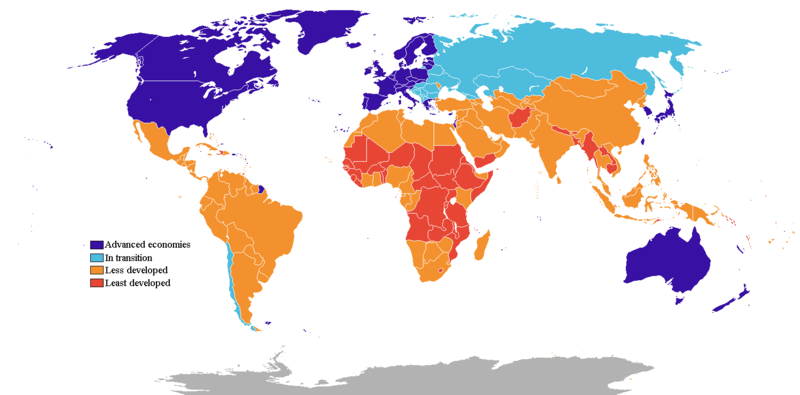
Size of this preview: 800 × 395 pixels. Other resolutions: 320 × 158 pixels | 640 × 316 pixels | 1,500 × 740 pixels.
Original file (1,500 × 740 pixels, file size: 46 KB, MIME type: image/png)
This file is from Wikimedia Commons and may be used by other projects. The description on its file description page there is shown below.
Summary
| DescriptionDeveloped and developing countries.PNG |
World map (updated 2019) showing advanced, transitioning, less and least developed countries. The CIA gives the following definitions:
Note: Due to overlap I removed the "four tigers" and the "least developed" countries from the "less developed" list and added Mongolia. __________________________________________________________________ |
| Date | |
| Source | self-made, data obtained from the CIA World Factbook |
| Author | Sbw01f |
Licensing
I, the copyright holder of this work, hereby publish it under the following licenses:

|
Permission is granted to copy, distribute and/or modify this document under the terms of the GNU Free Documentation License, Version 1.2 or any later version published by the Free Software Foundation; with no Invariant Sections, no Front-Cover Texts, and no Back-Cover Texts. A copy of the license is included in the section entitled GNU Free Documentation License.http://www.gnu.org/copyleft/fdl.htmlGFDLGNU Free Documentation Licensetruetrue |
This file is licensed under the Creative Commons Attribution 3.0 Unported license.
- You are free:
- to share – to copy, distribute and transmit the work
- to remix – to adapt the work
- Under the following conditions:
- attribution – You must give appropriate credit, provide a link to the license, and indicate if changes were made. You may do so in any reasonable manner, but not in any way that suggests the licensor endorses you or your use.
You may select the license of your choice.
Captions
Add a one-line explanation of what this file represents
Items portrayed in this file
depicts
April 2008
image/png
File history
Click on a date/time to view the file as it appeared at that time.
| Date/Time | Thumbnail | Dimensions | User | Comment | |
|---|---|---|---|---|---|
| current | 12:25, 15 May 2019 |  | 1,500 × 740 (46 KB) | wikimediacommons>Georgezh9617 | There was something wrong about Sweden. |
File usage
The following page uses this file:
Cookies help us deliver our services. By using our services, you agree to our use of cookies.